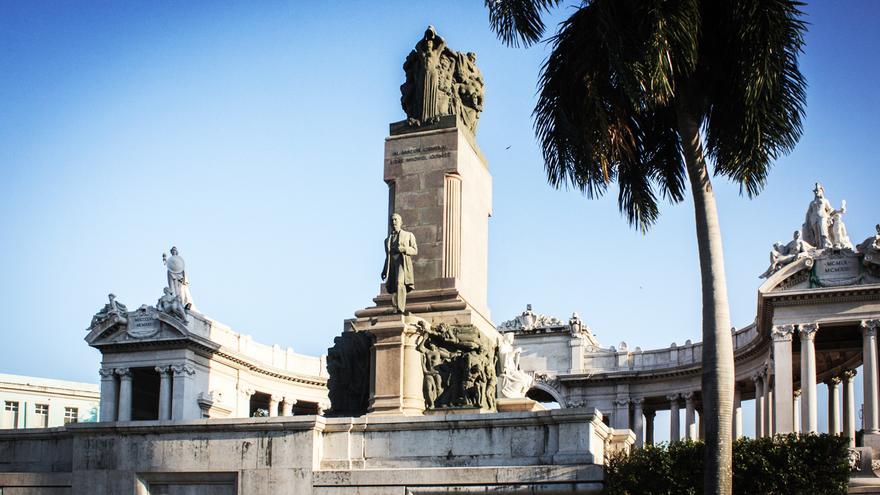
![]() 14ymedio, Yunior García Aguilera, Madrid, January 17, 2024 — The Cuban president with the biggest monument is perhaps Jose Miguel Gomez. In 2012, controversy arose over whether it was appropriate to preserve or demolish the gigantic sculptural complex at G and 29th streets in Havana. It all started with a song by the group Obsesión.
14ymedio, Yunior García Aguilera, Madrid, January 17, 2024 — The Cuban president with the biggest monument is perhaps Jose Miguel Gomez. In 2012, controversy arose over whether it was appropriate to preserve or demolish the gigantic sculptural complex at G and 29th streets in Havana. It all started with a song by the group Obsesión.
“Tear it down,” they rapped, “and don’t tell me this is about heritage / that it can’t be taken down because it belongs to Eusebio* / this is not a polite request / it is a demand from the people.” Some see the monument as a tribute to a racist, a man responsible for the massacre of independence fighters of color, which occurred a century earlier. For others, Gomez represents the personification of corruption. The only thing most Cubans know about our second president, however, is his nickname: Tiburón (the Shark). So obvious was his corruption that it was said of him, “When he swims, he splashes.”
Indeed, the ‘guajiro’ president was corrupt. There were several scandals during his tenure, such as a land exchange between Villanueva and Arsenal
Indeed, the guajiro president was corrupt. There were several scandals during his tenure, such as a land exchange between Villanueva and Arsenal. No one can deny that he emptied the coffers and left office with his pockets full. But the shark seems more like a sardine if we compare his appetite with those of the Castro brothers, who ended up taking over an entire country, spent decades destroying it, and gave us chicken instead of fish.
He was also a general in three wars of independence, a teenager who left school to take up arms, and an insurgent who rose through the ranks not from an armchair or hammock but on the battlefield.
By the time the Battle of Jíbaro ended, he was a major general and its hero. After the signing of the Treaty of Paris, which officially ended the Spanish-American War, he was one of nine generals invited to attend the handover ceremony. He later accompanied General Calixto Garcia on his visit to Washington. He was a member of the constituent assembly which drafted the country’s first constitution in 1901. He was appointed governor of Las Villas by U.S. General John Brooke and was later elected to that post by popular vote. By then, he was clearly one of the country’s most important figures, someone said to be “presidential material.”
As governor, he proved to be an excellent manager, building roads, improving agriculture and livestock, and investing in education. But perhaps his most notable achievement was the enormous popularity he gained among Afro-Cubans after appointing several black and mixed-race Cubans to posts in his government. Back then, absolutely no one considered him a racist.
To vote at that time, one had to be at least 21-years old, have a net worth of 250 pesos and be able to read. Members of the Liberation Army did not have to meet the last two requirements. And given the fact that most members of that army were of African descent, the black vote became a matter of utmost importance.
José Miguel wanted to be president so, with elections approaching, he launched an insurrection against the incumbent, Tomás Estrada Palma. For his part, Estrada Palma sought American military help, which led to a three-year period of U.S. occupation. In 1908, Gómez defeated Mario García Menocal, with 60% of the vote, to become president. His Liberal Party gained an absolute majority in Cuba’s House of Representatives. Though he and his allies would control the Senate, they had to deal with a new party: the Independents of Color (PIC).
The Liberals split into two factions: the nationalists, headed by Vice-President Alfredo Zayas, and the republicans, led by José Miguel
The Liberals split into two factions: the nationalists, headed by Vice-President Alfredo Zayas, and the republicans, led by José Miguel. One anecdote illlustrates the level of animosity between the two men. As the story goes, during the victory banquet, cigars were being passed around. Around the cigars were paper bands were images of both men printed on them. Gomez took one with the image of his vice-president on it, lit it and, in a jocular tone, said, “As for Zayas, I am smoking him.” El Chino, as Zayas was known, was not a smoker, so he responded in kind by saying, “And as for José Miguel… I am putting him in my pocket.”
Then came 1912. The PIC had been banned two years earlier. The Morúa Amendment, sponsored by a mulatto patriot, outlawed parties made up of a single racial group. The decision may have been controversial but it was fair, and several black patriots supported it. However, both conservatives and annexationists began adding fuel to the fire, seeking the overthrow of the liberals and end the American occupation. Faced with the uprising of the independents of color, Gomez acted with a heavy hand, one that was too harsh. More than 3,000 Afro-Cubans were slaughtered.
No, José Miguel was not a mackerel. He was a shark. But there was more than one culprit in that massacre.
*Translator’s note: a reference to the late Eusebio Leal, official historian of Havana, whose office was responsible for the restoration of the city’s historic center.
____________
COLLABORATE WITH OUR WORK: The 14ymedio team is committed to practicing serious journalism that reflects Cuba’s reality in all its depth. Thank you for joining us on this long journey. We invite you to continue supporting us by becoming a member of 14ymedio now. Together we can continue transforming journalism in Cuba.
